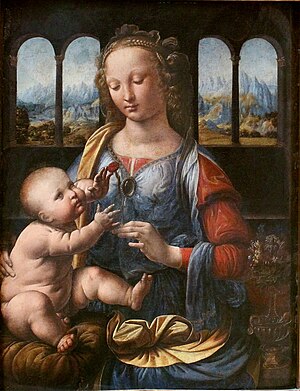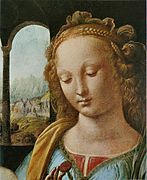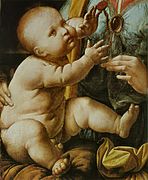Madonna with the Carnation

|
| Madonna with the Carnation |
|---|
| Leonardo da Vinci , between 1473 and 1478 |
| Oil on poplar wood |
| 62 × 47.5 cm |
| Alte Pinakothek , Munich |
The Madonna with the Carnation is a painting by Leonardo da Vinci that was painted between 1473 and 1478 at the end of the early Renaissance in Italy. The universal genius' early work has been exhibited in the Alte Pinakothek in Munich since 1889 and is the only da Vinci painting in a German museum.
The work
The work is 62.3 × 48.5 cm in size, it has been shortened by approx. 1.5 cm on the left and a few millimeters on the other sides. Later pieces were added to the left and right. A crack that was only visible on the back was secured.
Due to the strong curvature of the poplar wood panel, the back was planed off. The oil paint has wrinkles, which (according to Zöllner) suggest insufficient knowledge of oil paints. The use of oil-bound colors for painting was still new at the time. The painting technique used is tempera and oil paint on poplar wood. The ornate, colorfully painted frame dates from the Renaissance period . The state of preservation is good.
motive
The picture shows a young Madonna with the Christ Child, a common motif in Christian art of the Middle Ages. The young woman stands behind a balustrade , the baby Jesus sits on the railing in an unnatural position and is held by the Madonna with one arm. His raised left leg points to the folds of the golden yellow petticoat , which represents a lying figure eight . This is an indication of the birth of Christ , cf. Fish (Christianity) .
In the center of the picture is a red carnation which the Madonna is looking at; the child, on the other hand, looks up to the sky. The carnation is depicted mysteriously in the shadow, while the faces of the figures appear in the light. The picture has three levels of depth: the foreground with the child, the area behind the people up to the windows and the landscape.
There are four windows in the background that could indicate the four cardinal points or the four elements . A landscape with a horizon is depicted in the background, with the mountains to the left and right of the Madonna's head slightly inclined towards it.
The Christ child is well fed and naked. The Madonna wears valuable contemporary clothing with an oversized brooch , cf. Rock Grotto Madonna . It is not known whether a woman was a model.
history
The Virgin and Child is as a result of the carnation that Mary holds in her hand Madonna with the Carnation referred. The picture is an early work by Leonardo, which was probably created in the workshop of Andrea del Verrocchio . The provenance of the Madonna with the Carnation does not go far back. Its oldest, proven place of storage is the Wetzler pharmacy in Günzburg an der Donau. It is not known exactly how the painting got to Günzburg. Either it was in the nearby Burgau monastery or it was brought back from Italy by Auxilianus Urbani, an art collector who married into the Günzburg pharmacy in 1792 (Möller 1937).
The doctor Albert Haug bought the painting at auction in 1889 for only 22 marks from the estate of the widow Therese Wetzler. In 1889 he sold the painting to the Alte Pinakothek in Munich for 800 marks - the estimated price at the time was 8,000 marks. After the picture was acquired for the Alte Pinakothek, at the instigation of Adolf Bayersdorfer , it was immediately declared as an autograph work by Leonardo. He identified it with the Madonna with the carafe mentioned by Vasari , which was in the collection of Pope Clement VII around 1550 . In a picture analysis carried out in 1890, Wilhelm Koopmann also came to the conclusion that the picture from the Verrocchio workshop could only have been painted by Leonardo himself.
In 1906 Marcel Reymond claimed it for Verrocchio himself, while in 1909 Woldemar von Seidlitz was only able to recognize a picture in the manner of Verrocchio. Schmid tried (1893) to ascribe the picture to Lorenzo di Credi . He was left alone with the view. In contrast, Giovanni Morelli (1886), Rieffel (1891), Thiis (1909) and Venturi (1909) even only took the view that the picture was a copy of a lost Leonardo work. But as early as 1925 Venturi revised his previous view and now advocated that it was a work by Leonardo. Most art historians followed him to this day. A drawing by Leonardo in the Louvre in Paris, showing a head of the Madonna, seems to substantiate this ascription. The brooch that Maria wears in the picture is striking and can also be seen on the Madonna Dreyfus in the National Gallery of Art in Washington, DC and the Madonna Benois in St. Petersburg .
- Details
literature
- Cornelia Syre, Jan Schmidt, Heike Stege et al .: Leonardo da Vinci - The Madonna with the Carnation , exhibition in the Alte Pinakothek, Schirmer / Mosel Munich, 2006, ISBN 978-3-8296-0272-3 .
Web links
Individual evidence
- ↑ Alte Pinakothek
- ↑ Room IV, inv. No. 7779







